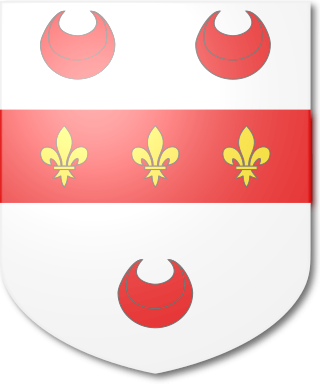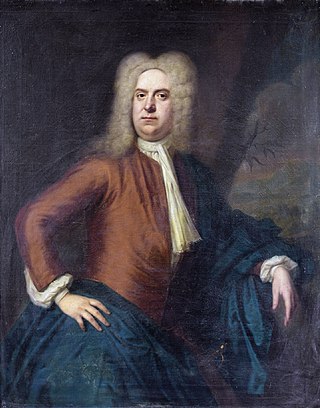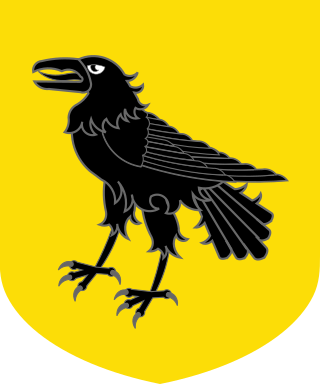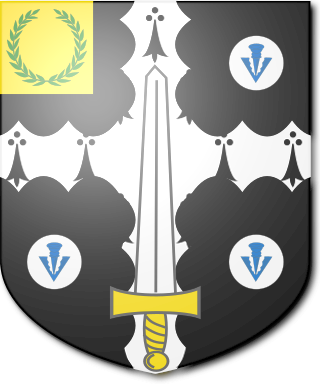Arms
 |
|
The Peacocke Baronetcy, of Grange in the County of Limerick and of Barntinck in the County of Clare, was a title in the Baronetage of the United Kingdom. It was created on 24 December 1802 for Sir Joseph Peacocke, of Grange, County Limerick. [1] Sir Joseph was the son of George Peacocke Esq. and his wife Mary (Levett) Peacocke, daughter of Joseph Levett, Alderman, of Cork, Ireland. [2] The title became extinct on the death of his grandson, the third Baronet, in 1876. [3]
 |
|

The Chaytor family is an English gentry family on which has been conferred two baronetcies, one in the Baronetage of England and one in the Baronetage of the United Kingdom and several knighthoods. As of 2008 one baronetcy is extinct.

There have been two baronetcies created for persons with the surname Head, one in the Baronetage of England and one in the Baronetage of the United Kingdom. One creation is extant as of 2007.

The Oakeley Baronetcy, of Shrewsbury, is a title in the Baronetage of Great Britain. It was created on 5 June 1790 for the Indian administrator Charles Oakeley. He served as Governor of Madras from 1790 to 1794. Frederick Oakeley was the second son of the first Baronet.

The Baronetcy of Gresley of Drakelow was created in the Baronetage of England on 29 June 1611 for George Gresley of Drakelow Hall, Derbyshire who was later High Sheriff of Derbyshire and Member of Parliament for Newcastle-under-Lyme.
Sir Matthew Deane, 3rd Baronet was an Irish baronet and politician.

Thomas Southwell, 1st Baron Southwell PC (Ire), known as Sir Thomas Southwell, 2nd Baronet from 1681 to 1717, was an Irish peer and politician.
Sir Tristram Beresford, 1st Baronet was an Anglo-Irish soldier and politician. He was the ancestor of the Marquesses of Waterford, the Barons Decies and the Beresford baronets, of William Beresford, 1st Viscount Beresford and Charles Beresford, 1st Baron Beresford.

The Milnes baronetcy, of Gauley in the County of Leicester, was a title in the Baronetage of the United Kingdom. It was created on 21 March 1801 for the colonial governor Robert Milnes. The title became extinct on the death of the invalid second Baronet in 1839, the only surviving son, "after many years in delicate and precarious health" residing at Sydling.

The Bayntun-Sandys Baronetcy, of Miserden Castle in the County of Gloucester and of Chadlington Hall in the County of Oxford, was a title in the Baronetage of the United Kingdom. It was created on 26 September 1809 for Edwin Bayntun-Sandys (1774–1848). He had been born Edwin or Edwyn Sandys, but had assumed the additional surname of Bayntun. He did so, by Royal sign manual, in 1807. The change was in order to inherit from the will of William Bayntun (1717–1785), a lawyer of Gray's Inn and husband of his first cousin once removed, Catherine Sandys (1737–1804).

Sir Roger Martin, 1st Baronet was son of Richard Martin and Jane, daughter of Sir Henry Bedingfield of Oxborough. He was created a baronet 28 March 1667 and was the first of the five Martin Baronets of Long Melford.

Sir Roger Martin, 2nd Baronet was son of Sir Roger Martin, 1st Baronet and Tamworth, daughter of Edward Horner of Mells, Somerset. He inherited his baronetcy from his father, who was the first Martin Baronet of Long Melford created on 28 March 1667, upon his death in 1712.

Sir Roger Martin, 3rd Baronet was son of Sir Roger Martin, 2nd Baronet and Anna-Marie Harvey. He inherited his baronetcy from his father, who was the second Martin Baronet of Long Melford, upon his death in 1762.

Sir Roger Martin, 5th Baronet was son of Sir Mordaunt Martin, 4th Baronet and Everilda-Dorothea Smith. He inherited his baronetcy from his father, who was the fourth Martin Baronet, upon his death in 1815. He lived in Burnham Market in Norfolk
The Hunt, later de Vere Baronetcy, of Curragh in the County of Limerick, was a title in the Baronetage of Ireland. It was created on 4 December 1784 for Vere Hunt, who subsequently represented Askeaton in the Irish House of Commons. The second Baronet assumed the surname of de Vere in lieu of his patronymic in 1832. The fourth Baronet represented County Limerick in Parliament. The title became extinct on his death in 1904.
Sir John Kennaway, 1st baronet, of Escot House in the parish of Talaton in Devon, was a British soldier and diplomat.
Sir Thomas Southwell, 1st Baronet, of Castle Mattress was a high sheriff of County Kerry under the Protectorate.

Sir James Chatterton, 1st Baronet, was an Irish lawyer and politician, and the first of the Chatterton Baronets of Castle Mahon.
Sir James Graham, 1st Baronet was a British Tory politician.

The Corbet baronetcy, of Moreton Corbet in the County of Shropshire, was created in the Baronetage of England on 29 January 1642 for the Royalist Vincent Corbet. Both he and the second Baronet sat as Members of Parliament for Shropshire.

The Fletcher baronetcy, of Carrow in the County of Cork, was a title in the Baronetage of the United Kingdom. It was created on 14 December 1812 for Richard Fletcher of the Royal Engineers. He died in August 1813 at the Siege of San Sebastián. The baronetcy was extinct on the death of the 2nd Baronet in 1876.